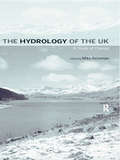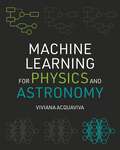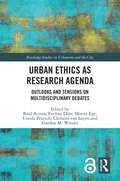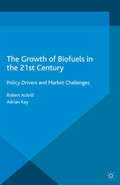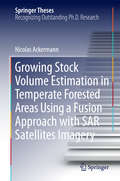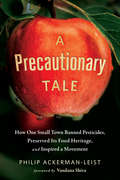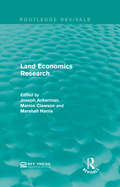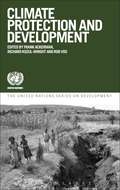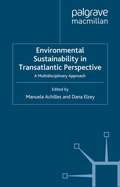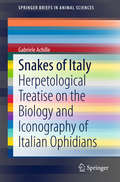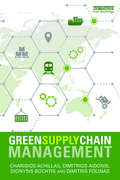- Table View
- List View
Investigating Groundwater (IAH - International Contributions to Hydrogeology #29)
by Ian AcworthInvestigating Groundwater provides an integrated approach to the challenges associated with locating groundwater. Uniquely, the book provides a review of the wide range of techniques that can be deployed to investigate this important resource. Many of the practical examples given are based upon Australian experience but the methods have worldwide applicability. The book is published in colour and includes many original diagrams and photographs. Particular effort has been made to provide consistent terminology and SI units are used throughout the text Investigating Groundwater starts with an introduction to the historical significance of groundwater and gives an account of climate change. A description of the occurrence of groundwater in different rock types is then provided. A detailed account of surface water techniques is then followed by an account of the interconnections between surface water and groundwater. Four chapters describing groundwater hydraulics are then followed by four chapters describing the latest geophysical techniques. Once the best location of a borehole is determined using these techniques; chapters then describe appropriate drilling methods to use; provide a wide ranging review of geophysical logging, hydrochemical and isotopic techniques, before concluding with a detailed description of groundwater flow to a well. Written for a worldwide audience of degree level geology/engineering practitioners, academics and students involved in groundwater resource investigation methods; Investigating Groundwater is essential reading for those involved in groundwater research. Key Features: Presents the theoretical background and a detailed description of the techniques used in the investigation of groundwater. Describes the general occurrence of groundwater in different rock types; surface water hydrology and interconnected surface and groundwater systems. Provides detailed descriptions of geophysical techniques (seismic, electrical, gravity and heat) and an account of available geophysical logging methods. Reviews hydrochemical and isotope methods, followed by an account of drilling techniques. Gives a detailed account of radial flow to a well, including appropriate modelling and pump-testing techniques and a consideration of non-linear flow. Of interest to anyone involved in the development of groundwater resources, either for domestic supply, for agriculture or for mining.
Global City Challenges: Debating a Concept, Improving the Practice
by M. Acuto W. SteeleThe contributors illustrate what twin analytical and practical challenges emerge from juxtaposing cultural, economic, historical, postcolonial, virtual, architectural, literary, security and political stances to the concept of the 'global city'.
Public Policy in an Entrepreneurial Economy: Creating the Conditions for Business Growth (International Studies in Entrepreneurship #17)
by Zoltan J. Acs Roger R. StoughThis unique volume presents policy recommendations designed to promote entrepreneurship. It considers timely issues like impact of securities regulation, educational policy and intellectual property protection on entrepreneurship. In the process, the book addresses policies operating at the individual, national, regional, and international levels, and offers a unique perspective on several institutional structures that enhance entrepreneurship and economic growth.
The Hydrology of the UK: A Study of Change (Routledge Environmental Management)
by Mike AcremanThe Hydrology of the UK assesses the changing hydrology of the UK, focusing on key issues that affect the fundamental hydrological processes and have important implications for water resource management, flood risk and environmental quality. The bookis divided into 3 sections: Section 1 examines the causes of change to the hydrology of the UK, including the impact of climate change, land use and geomorphological change, and dam construction. Section 2 assesses the effects of these pressures on UK rivers, goundwater, lakes, ponds, reservoirs and wetlands, looking at water quality, degradation, pollution and protection. Section 3 examines the responses of goverment organisations responsible for planning and management of water, including Environment Agencies, British Hydrological Society and the growing urgency for a World Hydrology Initiative.Change will continue to be a major feature of UK hydrology in the future. This book provides an understanding of the changing hydrology of the UK and the international scene today and looks to the needs for the future.
The Hydrology of the UK: A Study of Change (Routledge Environmental Management)
by Mike AcremanThe Hydrology of the UK assesses the changing hydrology of the UK, focusing on key issues that affect the fundamental hydrological processes and have important implications for water resource management, flood risk and environmental quality. The bookis divided into 3 sections: Section 1 examines the causes of change to the hydrology of the UK, including the impact of climate change, land use and geomorphological change, and dam construction. Section 2 assesses the effects of these pressures on UK rivers, goundwater, lakes, ponds, reservoirs and wetlands, looking at water quality, degradation, pollution and protection. Section 3 examines the responses of goverment organisations responsible for planning and management of water, including Environment Agencies, British Hydrological Society and the growing urgency for a World Hydrology Initiative.Change will continue to be a major feature of UK hydrology in the future. This book provides an understanding of the changing hydrology of the UK and the international scene today and looks to the needs for the future.
Machine Learning for Physics and Astronomy
by Viviana AcquavivaA hands-on introduction to machine learning and its applications to the physical sciencesAs the size and complexity of data continue to grow exponentially across the physical sciences, machine learning is helping scientists to sift through and analyze this information while driving breathtaking advances in quantum physics, astronomy, cosmology, and beyond. This incisive textbook covers the basics of building, diagnosing, optimizing, and deploying machine learning methods to solve research problems in physics and astronomy, with an emphasis on critical thinking and the scientific method. Using a hands-on approach to learning, Machine Learning for Physics and Astronomy draws on real-world, publicly available data as well as examples taken directly from the frontiers of research, from identifying galaxy morphology from images to identifying the signature of standard model particles in simulations at the Large Hadron Collider.Introduces readers to best practices in data-driven problem-solving, from preliminary data exploration and cleaning to selecting the best method for a given taskEach chapter is accompanied by Jupyter Notebook worksheets in Python that enable students to explore key conceptsIncludes a wealth of review questions and quizzesIdeal for advanced undergraduate and early graduate students in STEM disciplines such as physics, computer science, engineering, and applied mathematicsAccessible to self-learners with a basic knowledge of linear algebra and calculusSlides and assessment questions (available only to instructors)
Ecology of Wildlife Diseases in the Neotropics
by Gerardo Acosta-Jamett Andrea ChavesThis contributed volume focuses on the Neotropical region, and explores the environmental, ecological and socio-economic components that facilitate the emergence of zoonotic diseases. This book highlights the primary ecological, environmental, social, and economic variables associated with the risk of maintenance, transmission, and dissemination of emerging, re-emerging, and neglected infectious diseases, in which Neotropical vertebrates are involved. It compiles up-to-date knowledge and research for the neotropical region, as well as discusses the current needs of knowledge improvement. The chapters include various examples of the cycles of infectious diseases, all with world-wide relevance where neotropical wild vertebrates are affected or involved.
Urban Ethics as Research Agenda: Outlooks and Tensions on Multidisciplinary Debates (Routledge Studies in Urbanism and the City)
by Raúl Acosta Eveline Dürr Moritz Ege Ursula Prutsch Clemens Van Loyen Gordon M. WinderThis book provides an outline for a multidisciplinary research agenda into urban ethics and offers insights into the various ways urban ethics can be configured. It explores practices and discourses through which individuals, collectives and institutions determine which developments and projects may be favourable for dwellers and visitors traversing cities. Urban Ethics as Research Agenda widens the lens to include other actors apart from powerful individuals or institutions, paying special attention to activists or civil society organizations that express concerns about collective life. The chapters provide fresh perspectives addressing the various scales that converge in the urban. The uniqueness of each city is, thus, enriched with global patterns of the urban. Local sociocultural characteristics coexist with global flows of ideas, goods and people. The focus on urban ethics sheds light on emerging spaces of human development and the ways in which ethical narratives are used to mobilize and contest them in terms of the good life. This timely book analyses urban ethical negotiations from social and cultural studies, particularly drawing on anthropology, geography, and history. This volume will be of interest to scholars, researchers and practitioners interested in ethics and urban studies.
Volcano-Tectonic Processes (Advances in Volcanology)
by Valerio AcocellaVolcanoes have terrified and, at the same time, fascinated civilizations for thousands of years. Many aspects of volcanoes, most notably the eruptive processes and the compositional variations of magma, have been widely investigated for several decades and today constitute the core of any volcanology textbook. Nevertheless, in the last two decades, boosted by the availability of volcano monitoring data, there has been an increasing interest in the pre-eruptive processes related to the shallow accumulation and to the transfer of magma approaching the surface, as well as in the resulting structure of volcanoes. These are innovative and essential aspects of modern volcanology and, as driving volcanic unrest, their understanding also improves hazard assessment and eruption forecasting. So far, the significant progress made in unravelling these volcano-tectonic processes has not been supported by a comprehensive overview.This monograph aims at filling this gap, describing the pre-eruptive processes related to the structure, deformation and tectonics of volcanoes, at the local and regional scale, in any tectonic setting. The monograph is organized into three sections (“Fundamentals”, “Magma migration towards the surface” and “The regional perspective”), consisting of thirteen chapters that are lavishly illustrated. The reader is accompanied in a journey within the volcano factory, discovering the processes associated with the shallow accumulation of magma and its transfer towards the surface, how these control the structure of volcanoes and their activity and, ultimately, improve our ability to estimate hazard and forecast eruption.The potential readership includes any academic, researcher and upper undergraduate student interested in volcanology, magma intrusions, structural geology, tectonics, geodesy, as well as geology and geophysics in general.
The Growth of Biofuels in the 21st Century: Policy Drivers and Market Challenges (Energy, Climate and the Environment)
by R. Ackrill A. KayThis book provides a timely and insightful analysis of the expansion of biofuels production and use in recent years. Drawing on interviews with key policy insiders, Ackrill and Kay show how biofuels policies have been motivated by concerns over climate change, energy security and rural development.
Growing Stock Volume Estimation in Temperate Forested Areas Using a Fusion Approach with SAR Satellites Imagery (Springer Theses)
by Nicolas Ackermann"The PhD thesis written by Mr. Ackermann is an outstanding and in-depth scientific study that closes a research gap and paves the way to new developments. Despite the extremely complex issues, his work is very understandable and excellently elaborated."Prof. Dr. Christiane Schmullius "The PhD thesis written by Mr. Ackermann is an excellent and very comprehensive work performed at the highest scientific level. It examines in detail the potential of SAR data with regards to the derivation of forest stem volume in the temperate latitudes. The work belongs to a technically complex field. Nevertheless, Mr. Ackermann has succeeded in presenting the content in a clear and understandable way."Dr. Christian Thiel "The proposed document is overall of very good quality. Mr. Ackermann has done an exhaustive analysis of the in-situ data available on the Thuringian forest and was able to derive Growing Stocking Volume using L- and X-band spaceborne SAR data. The document is very well structured with a good split of information between the core of the text presented in the 6 chapters and the 4 annexes, which contain detailed results. Mr. Ackermann’s English grammar is excellent and his syntax is crystal clear, making his document pleasant to read. The way arguments are presented is logical and Mr. Ackermann gives a lot of attention to ensuring that sound explanations properly support these arguments."Dr. Maurice Borgeaud
Photogrammetrie: Grundlagen, Verfahren, Anwendungen
by Friedrich AckermannIn den 13 Jahren seit Erscheinen der 6. Auflage dieses Buches hat sich die internationale Szene auch auf unserem Teilgebiet der Informationsgewinnung und -verarbeitung stark verändert. In der Informationsgewinnung ist dem klassischen Luftbild die moderne Fernerkundung zur Seite getreten, die teilweise mit neuartigen Sensoren arbeitet und sich vielfach der Erdsatelliten als deren Träger bedient. Die beiden Möglichkeiten, die Bild- (oder Gestalt-)information, die geometrische und die physikalische Information mit analogen oder mit digitalen Mitteln zu verarbeiten, sind kräftig weiterentwickelt worden und haben zu vielfältigen neuen Ergebnissen und Ansätzen zu weiteren Fort schritten geführt. Die auf unserem besonders automationsfreundlichen Gebiet durch die weitere Integration der Elektronischen Daten-Verarbeitung (EDV) und verschiedener Automationselemente zu erwartenden Veränderungen sind nicht ausgeblieben. Vor allem zeigte sich, daß die für das Vermessungswesen so wichtige Genauigkeit und Wirtschaft lichkeit der Punktbestimmung mit digitalen Methoden (bei gleichzeitiger Verfeinerung der mathematischen Modelle) um bedeutende, teilweise entscheidende Beträge gesteigert werden konnten. Damit haben sich im Gebäude der Photogrammetrie die Schwerpunkte verschoben. ' Diese Tatsache spiegelt sich mehr oder weniger deutlich in den Lehr- und Handbüchern, die in den letzten Jahren erschienen sind. So brachte das Jahr 1972 zugleich eine vier bändige französische "Photogrammetrie Generale" und eine dreibändige deutsche Dar stellung im "Handbuch der Vermessungskunde". Allein der Umfang dieser mehrbändigen Werke von 1220 bzw. 2321 Seiten macht deutlich, daß ein vergleichsweise schmaler Band wie der vorliegende sich angesichts der neuen Entwicklungen bewußt und deutlich zu beschränken hat. Nachdem Herr Prof. Ackermann sich zu einer gegenüber der 6.
A Precautionary Tale: How One Small Town Banned Pesticides, Preserved Its Food Heritage, and Inspired a Movement
by Philip Ackerman-Leist Vandana ShivaMals, Italy, has long been known as the breadbasket of the Tyrol. But recently the tiny town became known for something else entirely. A Precautionary Tale tells us why, introducing readers to an unlikely group of activists and a forward-thinking mayor who came together to ban pesticides in Mals by a referendum vote—making it the first place on Earth to accomplish such a feat, and a model for other towns and regions to follow. For hundreds of years, the people of Mals had cherished their traditional foodways and kept their local agriculture organic. Their town had become a mecca for tourists drawn by the alpine landscape, the rural and historic character of the villages, and the fine breads, wines, cheeses, herbs, vegetables, and the other traditional foods they produced. Yet Mals is located high up in the eastern Alps, and the valley below was being steadily overtaken by big apple producers, heavily dependent on pesticides. As Big Apple crept further and further up the region’s mountainsides, their toxic spray drifted with the valley’s ever-present winds and began to fall on the farms and fields of Mals—threatening their organic certifications, as well as their health and that of their livestock. The advancing threats gradually motivated a diverse cast of characters to take action—each in their own unique way, and then in concert in an iconic display of direct democracy in action. As Ackerman-Leist recounts their uprising, we meet an organic dairy farmer who decides to speak up when his hay is poisoned by drift; a pediatrician who engaged other medical professionals to protect the soil, water, and air that the health of her patients depends upon; a hairdresser whose salon conversations mobilized the town’s women in an extraordinarily conceived campaign; and others who together orchestrated one of the rare revolutionary successes of our time and inspired a movement now snaking its way through Europe and the United States. A foreword by Vandana Shiva calls upon others to follow in Mals’s footsteps.
Land Economics Research (Routledge Revivals)
by Joseph Ackerman Marion Clawson Marshall HarrisOriginally published in 1962, Land Economics Research brings together papers presented at a symposium in Nebraska in 1961 which deal with ideas, theories and suggestions in land economics to encourage problem-solving in American land issues. This report draws on all types of land, all situations and all economics problems related to land issues. This title will be of interest to students of Environmental Studies and Economics as well as professionals.
Land Economics Research (Routledge Revivals)
by Joseph Ackerman Marion Clawson Marshall HarrisOriginally published in 1962, Land Economics Research brings together papers presented at a symposium in Nebraska in 1961 which deal with ideas, theories and suggestions in land economics to encourage problem-solving in American land issues. This report draws on all types of land, all situations and all economics problems related to land issues. This title will be of interest to students of Environmental Studies and Economics as well as professionals.
Climate Protection and Development (The United Nations Series on Development)
by Frank Ackerman Richard Kozul-Wright Rob VosWriting about climate change often falls into one of two opposite traps - predicting either calamity or apathy - both of which this book avoids. This is not a story of gloom and doom, of inevitable climate catastrophe. On the contrary, this book spells out, in more detail than usual, what can and should be done to avert the real risks of disaster. Nor is it one of complacent congratulation for "win-win" initiatives, cautiously incremental steps, and "green" consumer choices. Climate Protection and Development summons us to an endeavour worthy of the resources and ingenuity of the twenty-first century - towards bold initiatives with big costs, and much bigger benefits. This book explores the interconnected issues of climate and development, laying the groundwork for just such a new deal. It presents a challenging agenda, and highlights the needs and perspectives of developing countries which may be unfamiliar or uncomfortable to readers in high-income countries. The unfortunate truth is that any large country, or group of mid-sized countries, can veto any global climate solution by refusing to participate, so a solution will only work if it works for everyone.
Can We Afford the Future?: The Economics of a Warming World
by Doctor Frank AckermanAccording to many scientists, climate change is a growing threat to life as we know it, requiring a large-scale, immediate response. According to many economists, climate change is a moderately important problem; the best policy is a slow, gradual start, to avoid spending too much. They can't both be right.In this book, Frank Ackerman offers a refreshing look at the economics of climate change, explaining how the arbitrary assumptions of conventional theories get in the way of understanding this urgent problem. The benefits of climate protection are vital but priceless, and hence often devalued in cost-benefit calculations. Preparation for the most predictable outcomes of global warming is less important than protection against the growing risk of catastrophic change; massive investment in new, low carbon technologies and industries should be thought of as life insurance for the planet.Ackerman makes an impassioned plea to construct a better economics, arguing that the solutions are affordable and the alternative is unthinkable. If we can't afford the future, what are we saving our money for?Can we Afford the Future? is part of The New Economics series, which uses the ideas behind a new, more human economics to provide a fresh way of looking at major contemporary issues.
Can We Afford the Future?: The Economics of a Warming World
by Doctor Frank AckermanAccording to many scientists, climate change is a growing threat to life as we know it, requiring a large-scale, immediate response. According to many economists, climate change is a moderately important problem; the best policy is a slow, gradual start, to avoid spending too much. They can't both be right.In this book, Frank Ackerman offers a refreshing look at the economics of climate change, explaining how the arbitrary assumptions of conventional theories get in the way of understanding this urgent problem. The benefits of climate protection are vital but priceless, and hence often devalued in cost-benefit calculations. Preparation for the most predictable outcomes of global warming is less important than protection against the growing risk of catastrophic change; massive investment in new, low carbon technologies and industries should be thought of as life insurance for the planet.Ackerman makes an impassioned plea to construct a better economics, arguing that the solutions are affordable and the alternative is unthinkable. If we can't afford the future, what are we saving our money for?Can we Afford the Future? is part of The New Economics series, which uses the ideas behind a new, more human economics to provide a fresh way of looking at major contemporary issues.
Der Beitrag von Smart Cities zu einer nachhaltigen Stadtentwicklung: Chancen und Risiken von Konzepten für eine intelligente Stadt (Studien zum nachhaltigen Bauen und Wirtschaften)
by Benedikt Acker Thomas GlatteDieses Fachbuch vermittelt einen umfassenden Überblick über den Beitrag, welchen eine Smart City zu einer nachhaltigen Stadtentwicklung leisten kann. Unter Bezugnahme aktuell präsenter Megatrends erfolgt eine systematische Einordnung der Rolle der Immobilienwirtschaft im umfassenden Konstrukt einer intelligenten Stadt. Mittels Analysen vielversprechender Konzepte im Bereich der Smart City wird dabei der zusätzliche Mehrwert herausgearbeitet, welcher im Kontext der Nachhaltigkeit bei der Modernisierung und Revitalisierung von Gebäuden und Quartieren entstehen kann.
Forest Development: Succession, Environmental Stress and Forest Management Case Studies
by Achim Dohrenbusch and Norbert BartschForest ecosystems are characterized by a steady change in their structure of function. Natural developments are more and more radically disturbed by human impact. Air pollution leads to soil acidification, change in nutrient budget and to a decreasing vitality of the trees. Forest management can prevent natural succession and often leads to less stable forests. In this book, selected results of 10 years of interdisciplinary ecosystem research are presented. Not only growth and physiological reactions on environmental stress, but also natural succession processes are described and analysed. Besides the description of forest development processes, based on longterm experiments and observation, conclusions for practical forest management are given.
Environmental Sustainability in Transatlantic Perspective: A Multidisciplinary Approach (Energy, Climate and the Environment)
by Manuela Achilles Dana ElzeyExperts from business, academia, governmental agencies and non-profit think tanks to form a transnational and multi-disciplinary perspectives on the combined challenges of environmental sustainability and energy security in the United States and Germany.
Snakes of Italy: Herpetological Treatise on the Biology and Iconography of Italian Ophidians (SpringerBriefs in Animal Sciences)
by Gabriele AchilleThis book offers a comprehensive review of the biology of snakes, focusing on Italian species. The snakes of Italy belong to the two families Colubridae and Viperidae, and for each species the systematic classification and chorology including distribution maps are presented. Furthermore, readers will learn how to carry out field studies, how to handle snakes and how to photograph them. The book concludes with a chapter on the iconography of historical Italian snakes and their importance in popular science, and one on myths and legends. This SpringerBriefs volume will appeal to herpetologists and technical staff. The section on iconography may also be of interest to museum staff.
Green Supply Chain Management
by Charisios Achillas Dionysis D. Bochtis Dimitrios Aidonis Dimitris FolinasToday, one of the top priorities of an organization’s modern corporate strategy is to portray itself as socially responsible and environmentally sustainable. As a focal point of sustainability initiatives, green supply chain management has emerged as a key strategy that can provide competitive advantages with significant parallel gains for company profitability. In designing a green supply chain, the intent is the adoption of comprehensive and cross-business sustainability principles, from the product conception stage to the end-of-life stage. In this context, green initiatives relate to tangible and intangible corporate benefits. Sustainability reports from numerous companies reveal that greening their supply chains has helped reduce operating cost, thus boosting effectiveness and efficiency while increasing sustainability of the business. Green Supply Chain Management provides a strategic overview of sustainable supply chain management, shedding light on the theoretical background and key principles of the topic. Specifically, this book covers various thematic areas including benefits and impact of green supply chain management; enablers and barriers on supply chain operations; inbound and outbound logistics considerations; and production, packaging and reverse logistics under the notion of "greening". The ultimate aim of this textbook is to highlight the challenges in the implementation of green supply chain management in modern companies and to provide a roadmap for decision-making in real-life cases. Combining chapter summaries and discussion questions, this book provides an accessible and student-friendly introduction to green supply change management and will be of great interest to students, scholars and practitioners in the fields of sustainable business and supply chain management.
Green Supply Chain Management
by Charisios Achillas Dionysis D. Bochtis Dimitrios Aidonis Dimitris FolinasToday, one of the top priorities of an organization’s modern corporate strategy is to portray itself as socially responsible and environmentally sustainable. As a focal point of sustainability initiatives, green supply chain management has emerged as a key strategy that can provide competitive advantages with significant parallel gains for company profitability. In designing a green supply chain, the intent is the adoption of comprehensive and cross-business sustainability principles, from the product conception stage to the end-of-life stage. In this context, green initiatives relate to tangible and intangible corporate benefits. Sustainability reports from numerous companies reveal that greening their supply chains has helped reduce operating cost, thus boosting effectiveness and efficiency while increasing sustainability of the business. Green Supply Chain Management provides a strategic overview of sustainable supply chain management, shedding light on the theoretical background and key principles of the topic. Specifically, this book covers various thematic areas including benefits and impact of green supply chain management; enablers and barriers on supply chain operations; inbound and outbound logistics considerations; and production, packaging and reverse logistics under the notion of "greening". The ultimate aim of this textbook is to highlight the challenges in the implementation of green supply chain management in modern companies and to provide a roadmap for decision-making in real-life cases. Combining chapter summaries and discussion questions, this book provides an accessible and student-friendly introduction to green supply change management and will be of great interest to students, scholars and practitioners in the fields of sustainable business and supply chain management.
Multiple Scales of Suspended Sediment Dynamics in a Complex Geometry Estuary (IHE Delft PhD Thesis Series)
by Fernanda Minikowski AcheteMany estuaries are located in urbanized, highly engineered environments. Cohesive sediment plays an important role due to its link with estuarine health and ecology. An important ecological parameter is the suspended sediment concentration (SSC) translated into turbidity levels and sediment budget. This study contributes to investigate and forecast turbidity levels and sediment budget variability at San Francisco Bay-Delta system at a variety of spatial and temporal scales applying a flexible mesh process-based model (Delft3D FM). It is possible to have a robust sediment model, which reproduces 90% of the yearly data derived sediment budget, with simple model settings, like applying one mud fraction and a simple bottom sediment distribution. This finding opens the horizon for modeling less monitored estuaries.Comparing two case studies, i.e. the Sacramento-San Joaquin Delta and Alviso Slough, a classification for estuaries regarding the main sediment dynamic forcing is proposed: event-driven estuary (Delta) and tide-driven estuary (Alviso Slough). In the event-driven estuaries, the rivers are the main sediment source and the tides have minor impact in the net sediment transport. In the tide-driven estuaries, the main sediment source is the bottom sediment and the tide asymmetry defines the net sediment transport.This research also makes advances in connecting different scientific fields and developing a managerial tool to support decision making. It provides the basis to a chain of models, which goes from the hydrodynamics, to suspended sediment, to phytoplankton, to fish, clams and marshes.



